35 Purple Leaf Plants (Including Plants with Purple and Green Leaves) – With Pictures
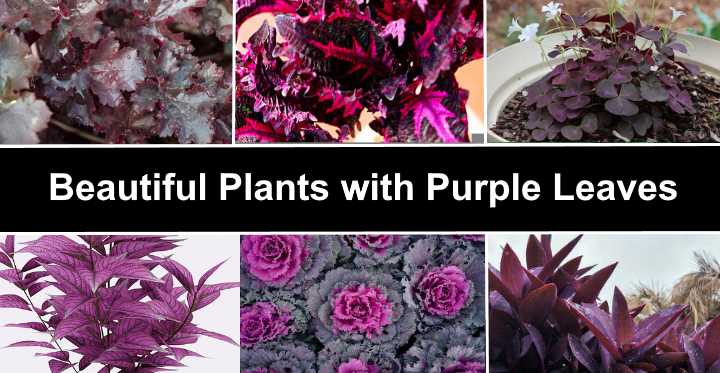
Purple leaf plants are perfect for adding vibrant color to garden landscapes or interior spaces. Purple-leafed plants can be eye-catching shrubs, trailing plants, leafy perennials, purple succulents, and annuals with dark-colored, dramatic foliage. In addition, plants with purple leaves stand out well with brightly colored flowers and add stunning contrast to green-leafed plants.
Purple leaf plants have dark leaves due to increased anthocyanin concentrations in the foliage. This pigment causes leaves to turn shades of purple from pale lilac to light pink, mauve, reddish purple, violet, amethyst, and dark purple, almost black. The colorful purple foliage can also display spectacular hues in the fall.
Some purple-leafed plants are famous for their dark leaves. For example, the purple shamrock, tradescantias, and Persian shield are popular plants known for their dark purple leaves. Other ornamental plants like coleus, coral bells, and succulents have multi-colored leaves that can be purple and green.
Are you looking for stunning shrubs and ornamental plants with gorgeous purple leaves to add vivid visual appeal to your landscape? Do you want to grow tropical, purple-leafed houseplants to enhance a room’s aesthetics? If so, please continue reading.
This article is a guide to attractive plants with purple leaves.
Purple Leaf Plants (Including Pictures) – Identification Guide
Purple is an unusual leaf color for garden shrubs, ornamentals, and houseplants. Some purple-leafed houseplants can have dark purple leaves with green margins. There are also tropical plants with foliage in shades of purple, with some varieties having variegated purple leaves.
Let’s look at the many varieties of indoor and outdoor plants with purple leaves.
Purple Shamrock (Oxalis triangularis)
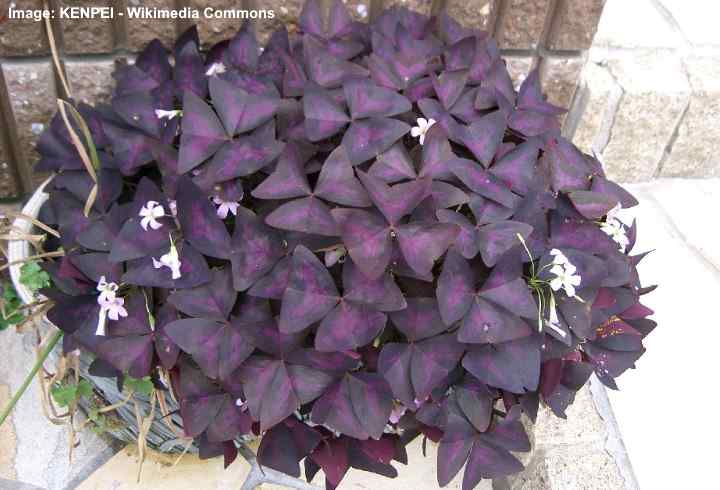
Purple shamrock is a flowering perennial plant with triangular dark purple leaves used as a low-growing foliage plant in gardens or as an attractive potted houseplant
The purple shamrock is an ornamental houseplant or garden plant with dark purple triangular leaves. The purple-leafed plant has trifoliate leaves that look like a purple shamrock. An unusual habit of the purple plant is the way its dark leaves close when disturbed or at night.
With its deep burgundy-maroon deltoid leaves, the purple shamrock plant grows 0.5 to 1.5 ft. (15 – 45 cm) tall. Three triangular purple leaves grow on a stem and measure up to 3” (75 mm). Due to its resemblance to other plants, this purple plant is also called false shamrock or purple wood sorrel.
Related reading: How to care for purple oxalis triangularis.
Purple Velvet Plant (Gynura Aurantiaca)
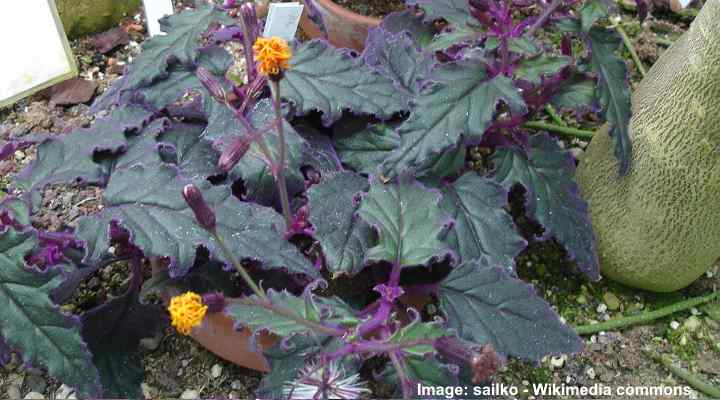
The green and purple leaves of purple velvet plant contrast nicely with its small, orange flowers
The purple velvet plant is a low-growing evergreen plant with purple and green leaves. Its velvety, fuzzy leaves have a dark green upper side and vivid purple underside. The purple velvet plant has characteristic purple stems and tiny orange-yellow flowers. The shade-loving tropical plant thrives in USDA zones 10 to 12.
Also called the purple passion vine, the colorful tropical houseplant is popular for hanging baskets. Its trailing stems with purple and green velvety leaves can grow up to 2 ft. (0.6 m) long. The furry purple leaves are 8” (20 cm) long and described as ovate with coarsely toothed margins and covered in reddish-purple hairs.
Boat Lily (Tradescantia spathacea)
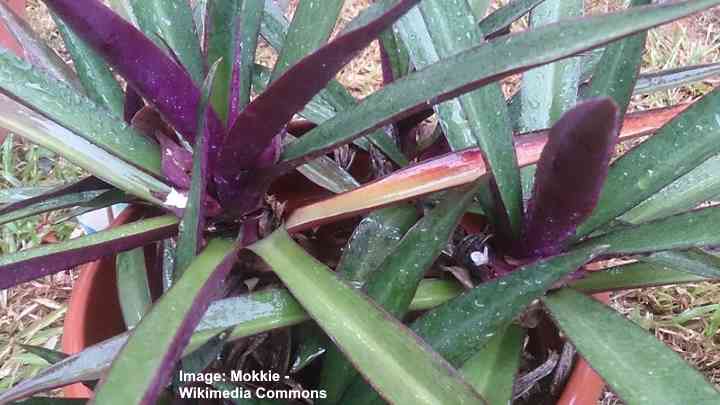
The boat lily plant has green leaves with purple underside and it grows best in indirect light
Boat lily is an evergreen perennial with sword-shaped dark green and purple leaves. This tradescantia houseplant adds plenty of visual appeal to any interior with its purple and green foliage and small boat-shaped white flowers. The slender, pointed purple leaves grow in a rosette pattern and measure up to 12” (30 cm) tall.
Boat lily plants are ideal leafy houseplants for shaded areas. However, for the most vibrant green and purple leaves, grow the spiky plant where it gets four to eight hours of filtered sunlight daily.
The most spectacular boat lily plants have green and dark pink variegated leaves. In addition, the pinkish and green striped leaves can have broad pale purple margins and green stripes in the center.
Other names for boat lily are the oyster plant, Moses-in-a-boat, cradle lily, and Moses in a basket plant.
Purple Heart Plant (Tradescantia pallida)
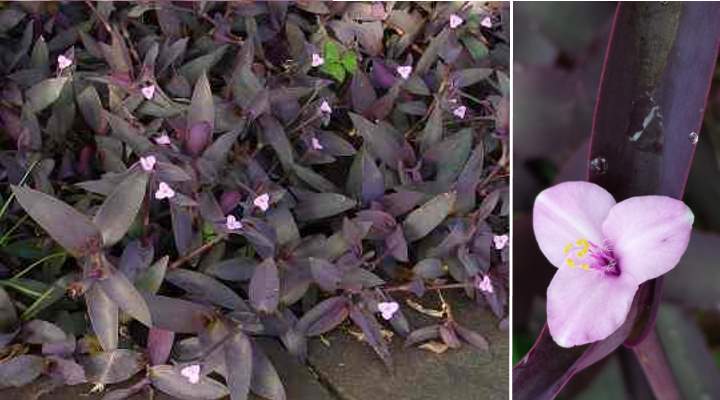
The purple heart trailing plant has deep purple pointed leaves and pale pink flowers
Also called purple spiderwort, the trailing wandering Jew plant has violet-purple leaves growing on long purple stems. The attractive dark-leaved plant with its pale pink flowers grows as an annual in gardens or as a beautiful indoor plant. The spectacular leathery, pointed oblong leaves are reddish-purple to almost black color.
The dark purple foliage on the purple heart tradescantia grows on stems up to 2 ft. (0.6 m) long. Unlike other tradescantia varieties, the ‘Purple Heart’ cultivar has pure purple leaves, not variegated or striped leaves.
Wandering Jew (Tradescantia zebrina)
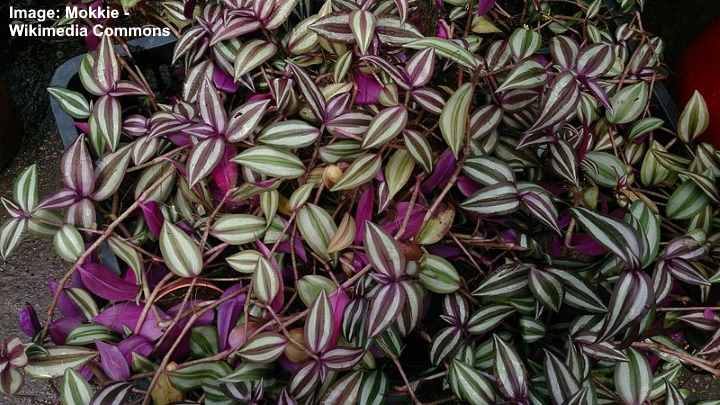
The green and purple striped leaves of the wandering Jew plant add beautiful color to hanging baskets or as a ground cover plant
Also called spiderwort plant, the wandering Jew is a tropical houseplant that can be identified by its lance-shaped purple and green striped leaves. The variegated, purple-leafed plant has stripy leaves that are green and pale gray on the upper side and purple on the underside. The purple and green tradescantia leaves have a slightly fuzzy texture.
The grayish-green and magenta foliage complement the plant’s purple and white flowers. When growing in hanging baskets or plant pots in partial sun, the wandering Jew has trailing vines up to 2 ft. (0.6 m) long. In USDA zones 8 through 12, you can grow wandering Jew as ground cover for partial shade.
Other names for the wandering Jew include silver inch plant, tradescantia tricolor, and tradescantia pendula.
Red Leaf Cordyline (Cordyline fruticosa ‘Rubra’)

The red leaf cordyline has elongated leaves with dark purple and pink leaves and can be grown as a houseplant in colder areas
Cordyline rubra is a large, evergreen, multi-stemmed tropical perennial with huge leaves that are a reddish-pink to burgundy-purple color. Its leathery leaves are bronze-green in the center, shading to burgundy and purple at the margins. The brightly colored foliage plant stands out among dark-leaved ornamental bushes.
The pink and purple leaves on the tropical cordyline plant grow 3 to 4 ft. (1 – 2 m) tall. Its eye-catching deep reddish-purple and pink leaves are ideal for landscaping as a specimen plant. You can also grow red leaf cordyline in pots indoors.
Canna Lily ‘Purpurea’ (Canna indica ‘Purpurea’)
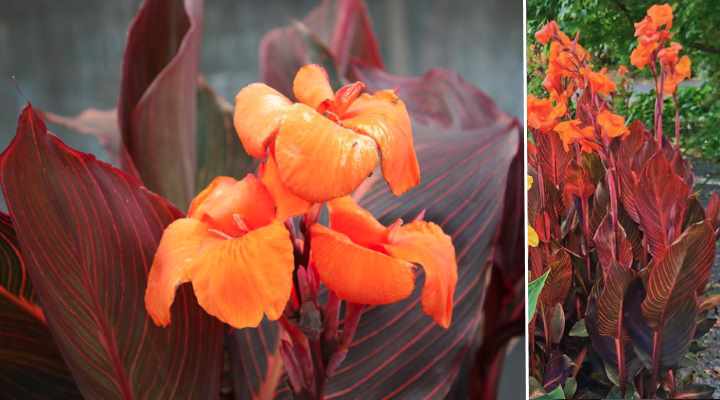
The colorful purple and reddish canna lily ‘Purpurea’ can be grown outdoors as an attractive foundation plant in warmer zones
The stunning purple and red leafed canna lily ‘Purpurea’ has large, broad leaves and spectacular orange flowers. The tall tropical plant foliage consists of oval, dark purple leaves with striking neon red veins. This densely growing ornamental plant grows 4 to 7 ft. (1.8 – 2.1 m) tall and 3 ft. (1 m) wide.
With its bold foliage, the eye-catching canna lily ‘Purpurea’ is suitable for semi-tropical and tropical gardens in USDA zones 8 to 11. In addition, the tall colorful plant is perfect for growing at the back of the border or mass planting along walls or foundations.
Dwarf Barberry Shrubs (Berberis thunbergii)
Dwarf barberry shrubs are thorny bushes with small, oval reddish-purple leaves. The colorful foliage and compact growth habit give the shrub plenty of ornamental appeal. In addition, the purplish leaves grow on barbed stems, making the bushes ideal for a security barrier or foundation plant.
Here are three varieties of dwarf barberry shrubs with reddish-purple foliage:
Golden Ring Barberry: An ornamental shrub for USDA zones 4 to 8 with purple oval leaves and thin greenish-yellow margins.
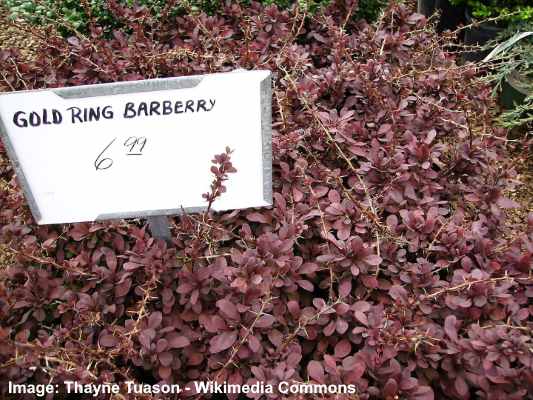
Golden Ring Barberry (Berberis thunbergii f. atropurpurea ‘Golden Ring’)
Rose Glow Barberry: The low-growing shrub has deep red-purple leaves, bright red berries, and tiny green flowers.
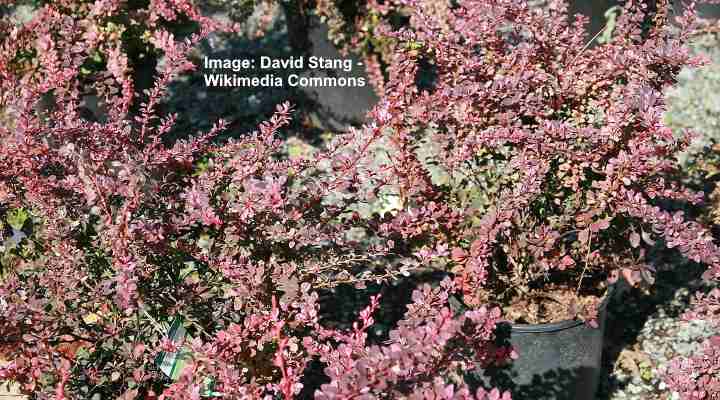
Rose Glow Barberry (Berberis thunbergii var. atropurpurea ‘Rose Glow’)
Helmond Pillar Barberry: The tall, purple-leafed ornamental shrubs have a distinctive columnar habit and grow 3 to 4 ft. (1 – 1.2 m) tall, 1 to 2 ft. (0.3 – 0.6 m) wide.
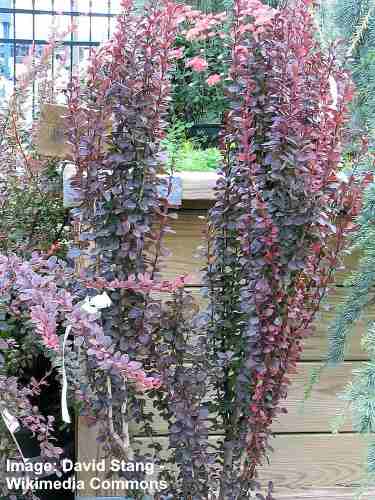
Helmond Pillar Barberry (Berberis thunbergii ‘Helmond Pillar’)
Persian Shield (Strobilanthes dyerianus)
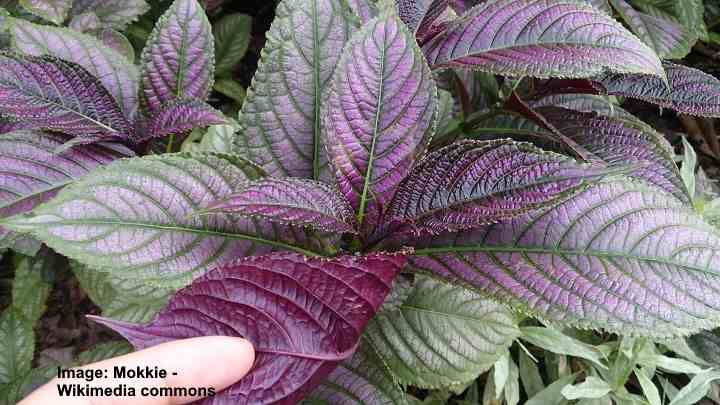
Persian shield has stunning foliage with purple, green and silver leaves
The Persian shield is an exotic tender perennial with shiny lilac, purple, green, and gray leaves. The plant’s distinctive, silvery foliage has light to dark purple shading in the center with bold, dark green veins and margins. Each purple and green iridescent lance-shaped leaf measures up to 7” (21 cm) long.
The colorful, purple-leafed plant is typically grown as an easy-grow houseplant for the shade. The fast-growing, mounding purple plant is popular for containers, hanging baskets, or planting in a semi-tropical shade garden.
Ornamental Cabbage (Brassica oleracea)
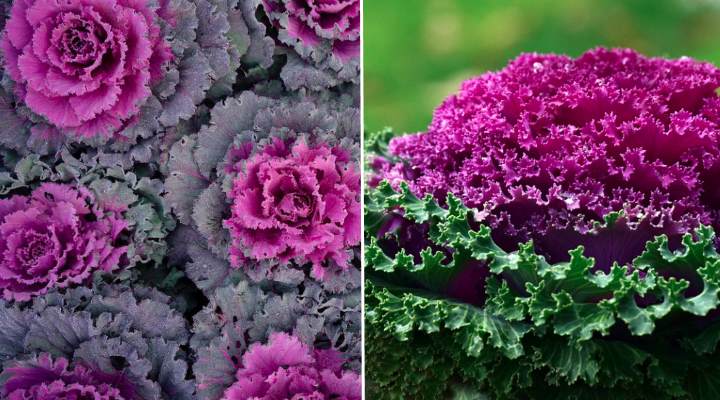
Ornamental cabbages have bitter taste and are usually grown as annuals for their attractive foliage
Ornamental flowering cabbages have leafy rosettes in light to deep shades of purple. The edible plant’s purple and green foliage has curly margins. Some of the most stunning ornamental cabbage plants have white and green leaves with pale lilac centers. Other ornamental cabbages have blackish-purple leaves with a vibrant pink-purple center.
Coleus with Purple and Green Leaves

A variety of coleus plants with purple or purple-green leaves
Coleus is a group of wonderful leafy plants famous for their colorful ovate leaves with scalloped margins. Many varieties of coleus plants have multi-colored leaves that can be burgundy, reddish-pink, bright purple, and vibrant green colors. The tender colorful plants are grown as annuals or houseplants.
Here are some spectacular examples of coleus plants with green and purple leaves:
Giant Exhibition Magma Palisandra: The large ovate leaves are a deep reddish-purple color with lime green margins.

Coleus Giant Exhibition Magma
Black Lace coleus (Solenostemon ‘Black Lace’): The deep purple triangular leaves on this coleus have deeply incised edges with bright green margins.
Black Magic coleus (Solenostemon ‘Black Magic’): This coleus hybrid is characterized by small deltoid purplish-black leaves with pale green margins.
Kong Scarlet coleus: This fast-growing foliage plant has huge burgundy-maroon leaves with deep green patterns around the edges.
Burgundy Wedding Train Coleus (Plectranthus ‘Burgundy Wedding Train’): This coleus is a trailing plant with green scalloped leaves and purple centers. This variety is popular for shaded window boxes and hanging baskets.
Flame Thrower Chili Pepper Coleus (Plectranthus ‘Flame Thrower Chili Pepper’): This compact coleus has slender pointed purple leaves with lime green tips. It’s one of the few coleus plants that thrives in full sun.
Coral Bell Plants with Purple Leaves (Heuchera)

Heuchera ‘Forever Purple’ (left) and ‘Palace Purple’ (right)
Coral bells are show-stopping foliage plants with deeply lobed plum-purple, pink-purple, maroon, and glossy burgundy leaves. This compact, clump-forming plant thrives in full sun to complete shade and performs well in most soils. The range of color combinations makes coral bells perfect for containers and mixed beds.
Here are some examples of coral bell plants with stunning purple leaves:
- Coral Bells ‘Forever Purple’ (Heuchera ‘Forever Purple’): The bold coral bells plants have glossy purple leaves with fluted margins. The stunning purple foliage plant keeps its vibrant purple hues throughout the year.
- Coral Bells ‘Grape Expectations’ (Heuchera ‘Grape Expectations’): This coral bell cultivar is a vibrant mounding plant with grape-purple leaves and dramatic black veins. The heat-tolerant, cold-hardy plant is ideal in mixed borders, containers, or as an accent plant.
- Purple Palace Coral Bells (Heuchera ‘Palace Purple’): This coral bells hybrid has large evergreen lobed leaves that are dark purple with burgundy red undersides. Tiny whitish-pink flowers contrast with the dark leaves.
Purple Leaf Cactus and Succulent Plants
Many succulents and cactus plants have attractive fleshy green and purple leaves. The purple succulents and cacti come in all shapes and sizes and add an exciting color twist to an indoor cactus garden. When growing succulents with purple leaves, it’s important to remember that sun exposure affects the purple tones.
Here are some attractive succulents with purple leaves:
Echeveria ‘Black Prince’: A stunning echeveria succulent with intense purple leaves growing in a rosette form. The succulent’s purple leaves are pointed, thick, and fleshy, and the color intensifies in full sun.
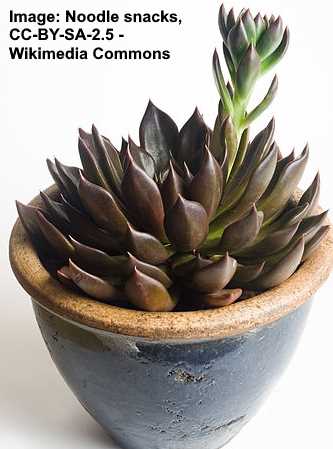
Echeveria ‘Black Prince’
Echeveria ‘Shaviana’ Pink Frills: This succulent has spoon-shaped, purple and pink leaves. The pink and purple shades become more intense in full sun exposure.
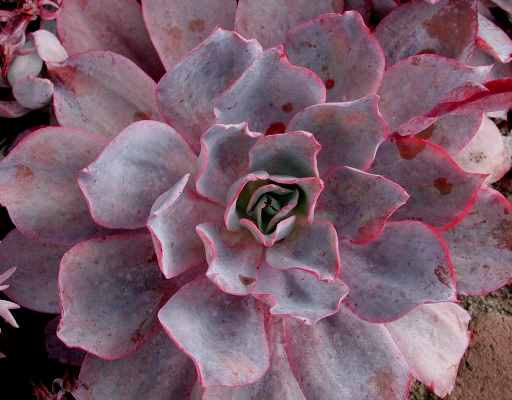
Echeveria ‘Shaviana’ Pink Frills
Black tree aeonium (Aeonium arboreum ‘Atropurpureum’): The spectacular black tree aeonium has dark reddish-purple leaves growing in a large rosette. The highlight of this succulent is its contrasting pale green center.

Aeonium arboreum ‘Atropurpureum
Lithops Optica ‘Rubra’: The unique lithops succulent has a distinctive shade of dark pink to dusty purple. The “living stones” grow fleshy leaves that split into two before a new purple succulent leaf emerges from the center.
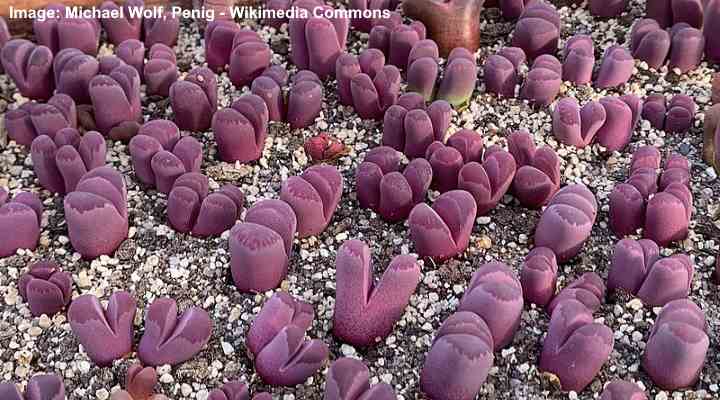
Lithops Optica ‘Rubra’
Stonecrop ‘Purple Emperor’ (Sedum telephium ‘Purple Emperor’)
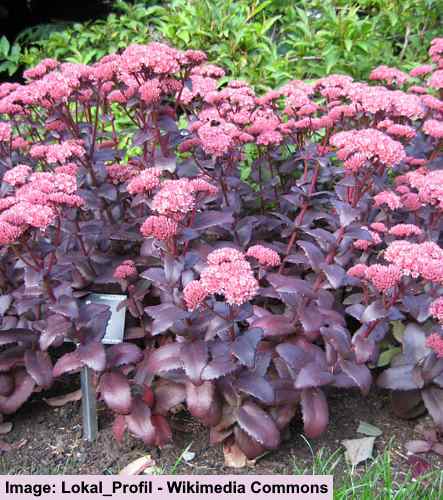
Stonecrop ‘Purple Emperor’ is a beautiful landscaping plant with purple leaves and pink flowers
Stonecrop plants with purple leaves create an eye-catching accent in a garden landscape. The vigorous plant is characterized by dark purple, fleshy leaves growing on reddish-purple stems. Large umbrella-shaped rosy-pink flowers complement the purple foliage to add to the plant’s attractiveness. Purple stonecrop grows 1 to 2 ft. (0.3 – 0.6 m) tall.
Purple-colored stonecrop is ideal for foundation planting, adding color to beds and borders, or planting along fences or walls.
Purple Leaf Weigela (Weigela florida ‘Wine & Roses’)
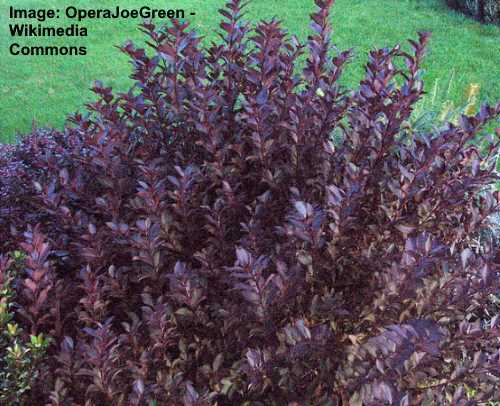
The dark purple leaves of Weigela florida ‘Wine & Roses’ shrub contrast beautifully with other green or colorful plants
Purple leaf weigela is an outstanding deciduous shrub with narrowly ovate dark purple leaves. With its rosy-pink trumpet shaped-flowers, the stunning shrub keeps its eye-catching colors throughout the season. The weigela cultivar has attractive purple foliage growing 4 to 5 ft. (1.2 – 1.5 m) tall in USDA zones 4 to 8.
The award-winning, purple-leafed shrub makes for perfect plant borders, foundation, or specimen shrub plantings.
Royal Purple Smokebush (Cotinus coggygria ‘Royal Purple’)
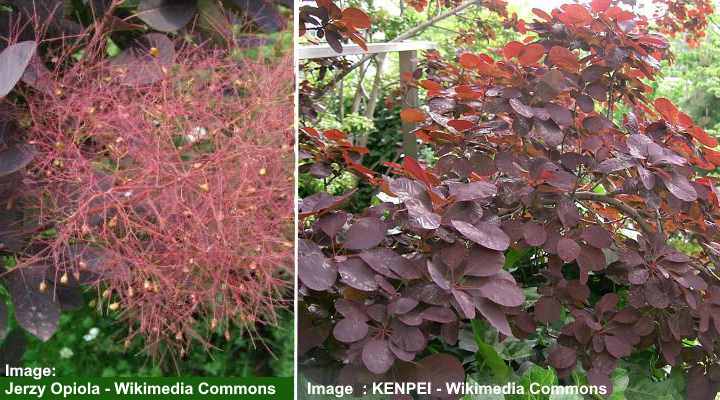
‘Royal Purple’ smokebush feathery flowers (left) and purple leaves (right)
The royal purple smokebush has foliage and flowers with rich, deep purple and burgundy colors. The vibrant purple egg-shaped leaves of the sizable shrubby plant look best growing in full sun. This dark foliage complements the pinkish-purple feathery flowers that bloom in mid-summer.
Thanks to its purple leaves and attractive flowers, the sizable bushy plant has visual appeal throughout the season. You can grow the ornamental shrub as a colorful hedge plant, privacy screen, accent plant, or border plant.
Inaba Shidare Japanese Maple (Acer palmatum var. dissectum ‘Inaba Shidare’)
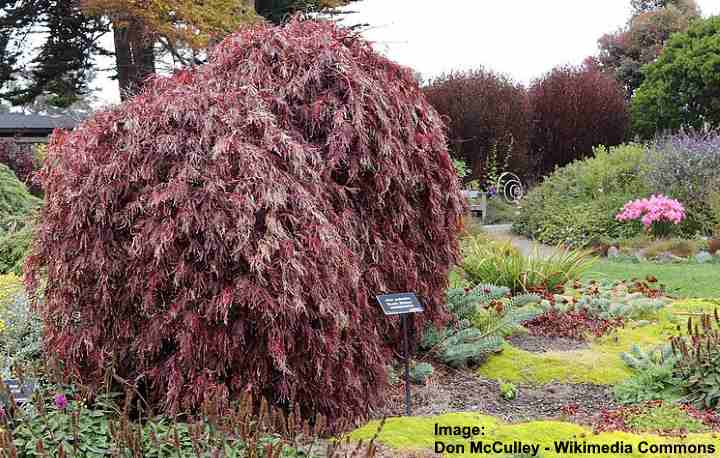
It takes about ten years for the dwarf ornamental Inaba Shidare maple to reach 6 ft. (1.8 m) tall
The weeping Inaba Shidare Japanese maple tree is an incredible plant with cascading stems covered in feathery, deep red, scarlet, and purple foliage. The purple shrub-like weeping tree’s foliage is so dark that the leaves look almost black. In addition, growing in the intense summer sun, the foliage becomes even more vibrant.
The Inaba Shidare Japanese dwarf maple is perfect for growing as a front-of-house specimen dwarf tree. However, you can also plant the miniature tree in a container for a patio or container garden.
Black Scallop Bugleweed (Ajuga reptans ‘Black Scallop’)

The low growing spreading black scallop bugleweed has shiny purple leaves and prefers part-sun locations
Black scallop bugleweed is a low-growing ground cover plant with dark purple, almost black, shiny scalloped leaves. The hardy, attractive bedding plant has glossy purple foliage that adds a dramatic pop of color to a garden landscape. In addition, tiny spikes of lavender flowers bloom in spring, adding to the perennial plant’s evergreen leaves.
Black scallop bugleweed grows 4” to 6” (12 – 15 cm) and spreads up to 12” (30 cm). You can grow the robust, purple-leafed plant in flower beds, rock gardens, or as a dark accent between stepping stones.
Purple Philodendron ‘Rojo Congo’ (Philodendron ‘Rojo Congo’)
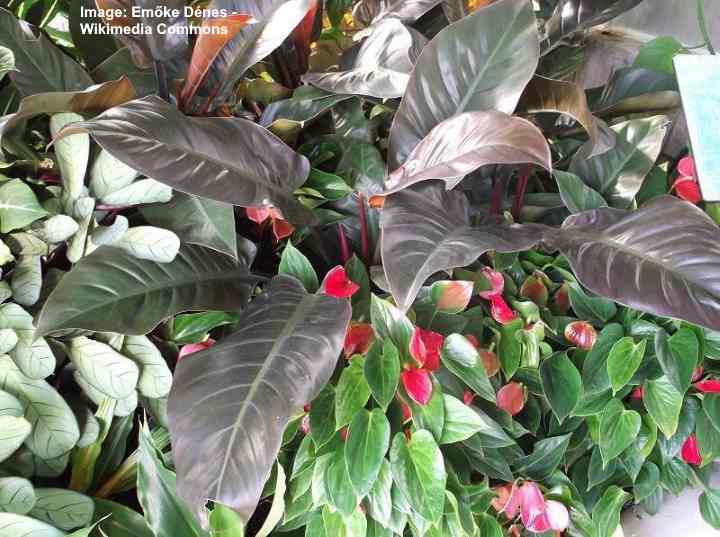
Philodendron ‘Congo Rojo’ is an attractive houseplant with dark purple-black leaves
The purple-leafed philodendron ‘Rojo Congo’ is a stunning houseplant with large, broad, dark purple leaves and purple stems. New leathery leaves emerge deep burgundy before turning purplish-black, then rich green. With its elongated dark oval leaves, this easy-to-care-for houseplant grows about 2 ft. (0.6 m) tall and wide.
Chinese Fringe Flower ‘Ever Red’ (Loropetalum chinense ‘Ever Red’)

The evergreen Chinese fringe flower cultivar ‘Ever Red’ has red flowers that look stunning against the dark purple foliage
The Chinese fringe flower plant is noted for its dark purple-burgundy leaves and brightly colored delicate red flowers with spindly petals. The red clusters of flowers emerge among the dark leathery leaves in late winter and early spring. The contrast between bright pink-red flowers and dark purple foliage is outstanding.
The Chinese fringe flower ‘Ever Red’ is an evergreen shrub that grows 6 ft. (1.8 m) tall. The versatile red-flowering shrub is ideal as a specimen plant growing in full sun. You can also use the red landscape plant as a hedge, privacy screen, foundation planting, or container plant. Grow in USDA zone: 7 to 9.
The Ninebark Diablo (Physocarpus opulifolius ‘Diabolo’)

The ‘Diabolo’ ninebark is a beautiful deciduous shrub prized for its dark purple foliage contrasting with attractive white flowers. The shrub blooms in spring with rounded clusters of pinkish-white flowers. The shrub’s maple-like leaves emerge purple and may fade to green in hot summers.
The ‘Diabolo’ ninebark cultivar grows 6 to 8 ft. (1.8 – 2.4 m) tall and wide, performing best in full sun and well-drained soil. In addition to its stunning deep purple leaves and white flowers, the shrub produces ornamental red berry-like fruits in the fall. After the leaves drop, the shrub reveals attractive peeling reddish-brown bark.
Landscaping uses for ninebark ‘Diabolo’ include hedges, mixed shrub borders, screens, or erosion control on banks. It performs best in USDA zones 3 to 7 and needs shelter from hot afternoon sun and overly humid climates.
Chinese Fringe Flower ‘Razzle Dazzle’ (Loropetalum chinense ‘Razzle Dazzle’)
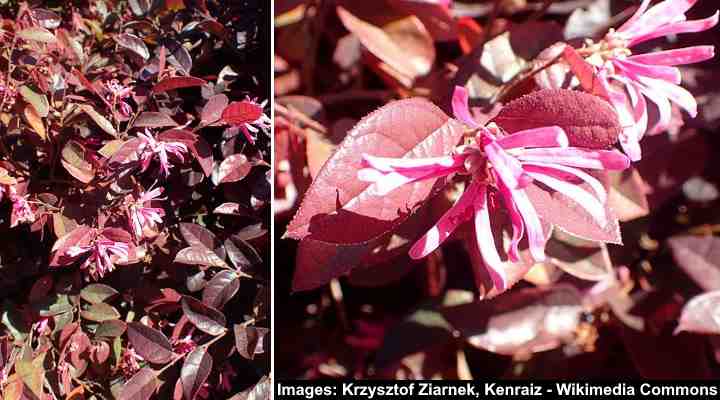
The Chinese fringe flower ‘Razzle Dazzle’ cultivar is a vibrant, colorful shrub thanks to its wiry pink spring flowers and burgundy-purple leaves. The dark, ovate leaves measure 2.5” (6 cm) long and have pointed tips and asymmetrical bases. This low-maintenance evergreen shrub has spidery pink blooms reminiscent of witch hazel flowers.
Chinese fringe flowers with purple leaves perform best in full sun. They grow 3 to 8 ft. (0.9 – 2.4 m) tall and up to 6 ft. (1.8 m) wide. They thrive in rich, acidic soil that drains well. The striking deep burgundy to purple foliage complements the beautiful, aromatic bright pink flowers.
The ‘Razzle Dazzle’ fringe flower cultivar has several uses in garden landscapes. The dramatic dark foliage looks stunning as an evergreen hedge, border plant, or focal point in the garden. You can also plant it along a foundation line to contrast with shrubs that have lighter foliage.
Japanese Maple Bloodgood (Acer palmatum var. atropurpureum ‘Bloodgood’)
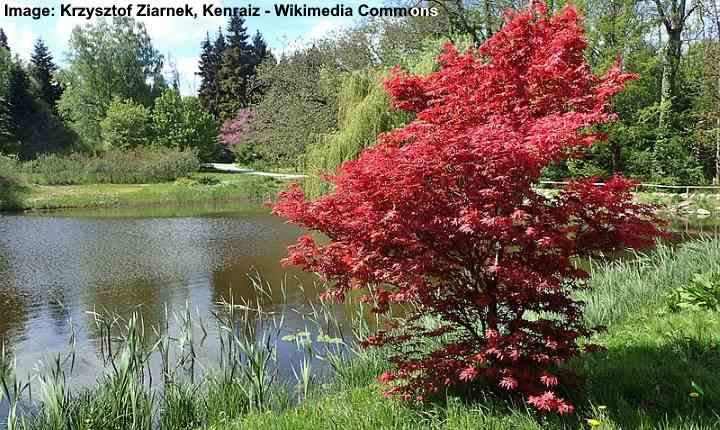
The Japanese maple ‘Bloodgood’ cultivar is considered one of the best purple-red leaved maples. The plant grows as a deciduous shrub or small ornamental tree. Its outstanding feature is its deep red-purple foliage. The palmate leaves have five to seven pointed lobes and develop a wine-red to burgundy color. Its striking fall foliage colors are vibrant crimson-red shades.
The Japanese maple ‘Bloodgood’ grows up to 20 ft. (6 m) tall and wide. In addition to its purple crimson leaves, the attractive tree has small purple flowers blooming in spring. These are followed by red fruits in late summer and early fall. Additionally, the blackish-red bark adds to the tree’s winter interest as a focal point.
The ‘Bloodgood’ Japanese maple cultivar performs well in USDA zones 5 to 8. As a small tree, it’s an ideal specimen plant, where its stunning deep purple foliage develops in partial shade. It’s a popular ornamental maple tree for adding a pop of color to the gardens in all seasons.
Purple-Leaf Sand Cherry (Prunus x cistena ‘Crimson Dwarf’)
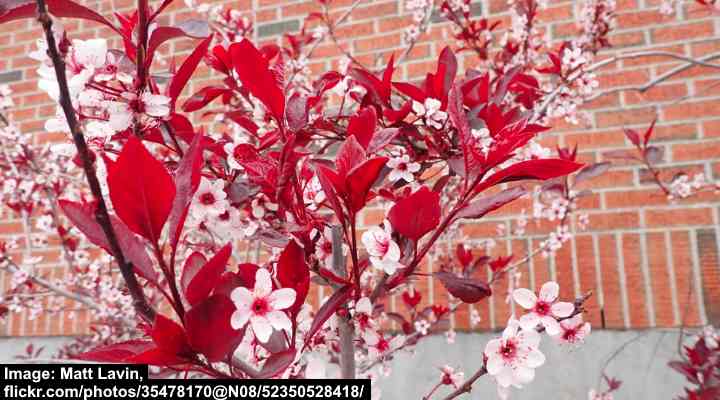
Purpleleaf sand cherry—also called dwarf red leaf plum—is a small deciduous shrub prized for its deep purple-reddish foliage and delicate pale pink or white flowers. The purple-leaved shrub blooms in spring, and its white flowers contrast nicely with dark foliage. Pollinators like bees, butterflies, and other beneficial insects are attracted to the flowers.
The ‘Crimson Dwarf’ purple-leaf sand cherry shrub is a popular landscaping shrub growing 6 to 10 ft. (1.8 – 3 m) tall and up to 8 ft. (2.4 m) wide.
The dwarf shrub has great aesthetic value in gardens. As the flowers fade, the deep purple crimson foliage adds dramatic colors to mixed borders, hedges, and screens. Or you can grow it as a focal point to add a pop of color to a front or backyard.
Black Cherry Plum (Prunus cerasifera ‘Nigra’)
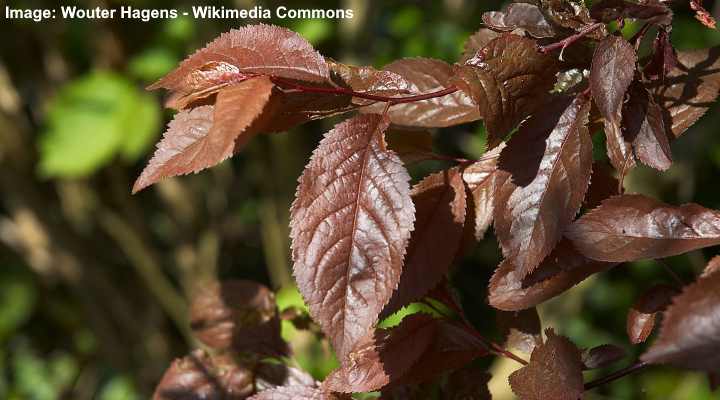
The black cherry plum, also known as Prunus cerasifera ‘Nigra’ is a deciduous tree with some of the darkest purple leaves on any fruit tree. The attractive purple, almost black foliage emerges bronze in spring, turns dark purple, and then spectacular orange and red shades in the fall. The cherry tree blooms in early spring with small bowl-shaped pale pink flowers on bare branches.
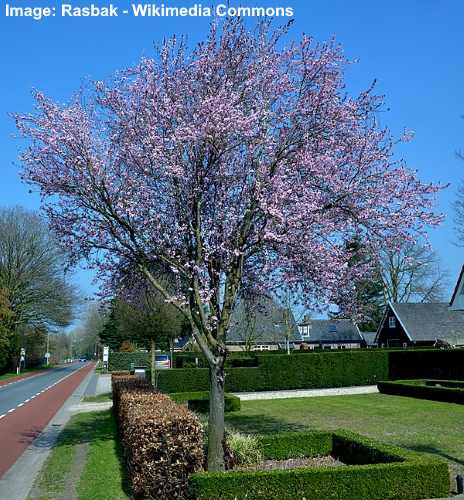
Prunus cerasifera ‘Nigra’ tree
Also called Prunus ‘Blaze,’ the fruit tree has an attractive rounded crown and grows 15 to 20 ft. (4.5 – 6 m) tall and wide. The pale to deep purple and orange shades of the flowers and foliage give the ornamental tree three-season appeal. It’s also easy to grow in most landscapes and suits small gardens.
The black cherry plum ‘Nigra’ is a versatile, visually stunning tree for landscapes. Apart from enjoying its spring blossoms, the tree can be pruned to grow as a beautiful screen or hedge to attract pollinators like butterflies and bees.
Osmin Purple Basil (Ocimum basilicum)

Osmin purple basil is a variety of sweet basil with extremely dark purple leaves. The shiny purple leaves have a lanceolate shape with sunken veins. The purple basil plant blooms with conical flowering spikes containing pink or pale purple tubular flowers. The bushy herbaceous purple plant grows 20” (50 cm) tall and wide.
Annual Osmin purple basil is also known for its strong, pungent, slightly sweet, and spicy flavor. The vibrant purple leaves add a splash of color to herb gardens, containers, or mixed flower beds. Not only do the glossy purple leaves provide a visual treat, but pinching the leaves encourages new growth and provides tasty herbs for cooking.
Other varieties of purple basil include dark opal basil (Ocimum basilicum ‘Dark Opal’), Rubin basil (Ocimum basilicum ‘Rubin’), and African blue basil (Ocimum basilicum ‘African blue’) which has purple leaves when young.
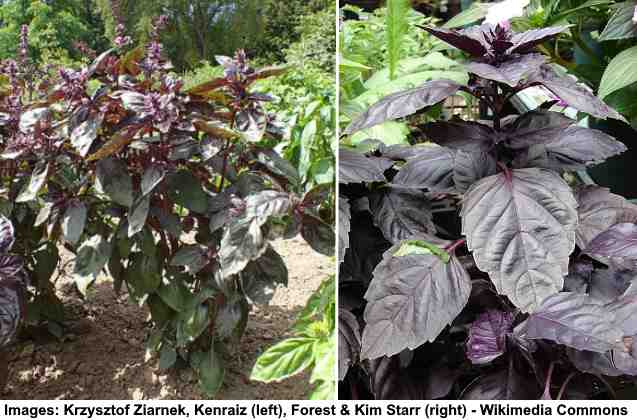
Ocimum basilicum ‘Dark Opal’ and ‘Rubin’
Common Purple Elderberry (Sambucus nigra ‘Guincho Purple’)
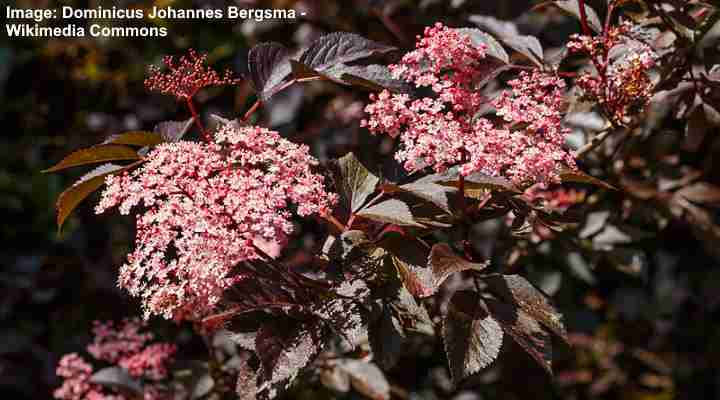
Elderberry ‘Guincho Purple’ cultivar is one of the most stunning purple-leaved shrubs or small trees. Its dramatic, lacy foliage consists of deeply dissected leaves in deep purple shades. The almost black leaves emerge in spring, turn green in summer, and revert to deep purple colors in the fall before dropping.
The upright habit of ‘Guincho Purple’ and dark foliage make the large shrub stand out in landscapes. This eye-catching deciduous shrub with deep purple leaves grows 8 to 15 ft. (2.4 – 4.5 m) tall and up to 8 ft. (2.4 m) wide. It blooms in spring with scented, rounded clusters of pinkish-purple flowers. These are followed by shiny black berries in late summer and fall.
The ‘Guincho Purple’ elderberry shrub is a great landscaping option for adding color and interest to sunny gardens. You can grow it as a mixed border, hedge, screen, or specimen plant. For the best foliage color, ensure the purple shrub gets at least six hours of sunlight daily.
Related articles:
